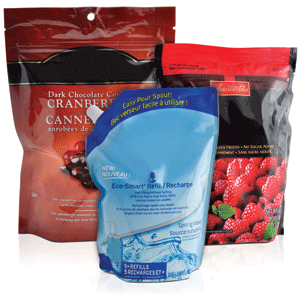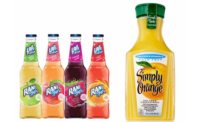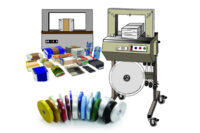
|
| Listening to the customer's needs will help to create the best pouch possible. |
Q: Pouches are an innovative and competitive category in packaging: How can film suppliers contribute to the R&D process?
A: Film suppliers can customize the production of film for pouches in eight specific ways: thickness, tolerance, roll geometry, seal initiation temperature, seal strength, sealing window or range, hot-tack property and seal-through contamination.
How these characteristics are customized depends on the selection criteria the customer sets for the intended packaging. Those criteria may include:
• Product compatibility: Does the packaging need to be sterilized? Does it require modified atmosphere packaging (MAP)? Is there a barrier requirement for specific foods?
• Mechanical properties: What kind of temperature ranges should the film be able to withstand? What is its impact resistance rating?
• Seal characteristics: Does the film require perforation? Are the contents liquid, solid or powder?
• Machinability: What kind of system will the film be running on? Is the equipment new or old? What kind of film flexibility is required for successful machining? How complicated is the pouch’s design and how does it impact manufacture? What kind of opening does it have? Perforated tear or spout?
• Cost: What kind of budget are you facing and how does that affect product design and manufacture?
• Special requirements: What level of convenience is required for the end user? What is this packaging replacing, if anything? Does it need to be tamper-proof? Is environmental footprint a consideration?
Q: What are some trends in pouch design and how can film selection, and film suppliers, help their customers meet these trends?
A: Although much has been said about consumers’ desire for convenience products, there are several other key trends in the marketplace that film suppliers are ideally poised to help their customers meet.
Peelability is one such trend. Film suppliers can influence how easy a pouch is to open by adjusting a film’s layers and its sealability. This is a nice innovation for children’s foodstuffs especially, where little hands often have the big job of opening a new box of morning cereal.
Another significant trend in produce is modified atmosphere packaging, or MAP. Many retailers are seeking ways to extend the shelf life of the produce they purchase and MAP is becoming an increasingly popular way to achieve this goal. With so many new produce items now being packaged in pouches, your film supplier can help find cost-effective solutions for extending the shelf life of these previously unpackaged foods.
Q: What should converters/laminators seeking innovative solutions for their clients look for when selecting a film supplier?
A: Ensure, first and foremost, that you are choosing the right package for the right product. Your film supplier should be able to help you ensure the package is not over-designed or under-designed for its intended purpose. If you’re seeking a customized product, ensure the film supplier you select is willing, and able, to have that conversation with you. Some suppliers offer à la carte products and pricing for the convenience of their customers, but this may not be what you need when seeking an innovative solution to a packaging challenge. Also ensure that the film being offered will run on the machinery in your factory: some suppliers can tweak their formulas to run on your machinery, while others may not.
Haremar Plastic Manufacturing Ltd
(905) 761-7552; www.haremar.com



